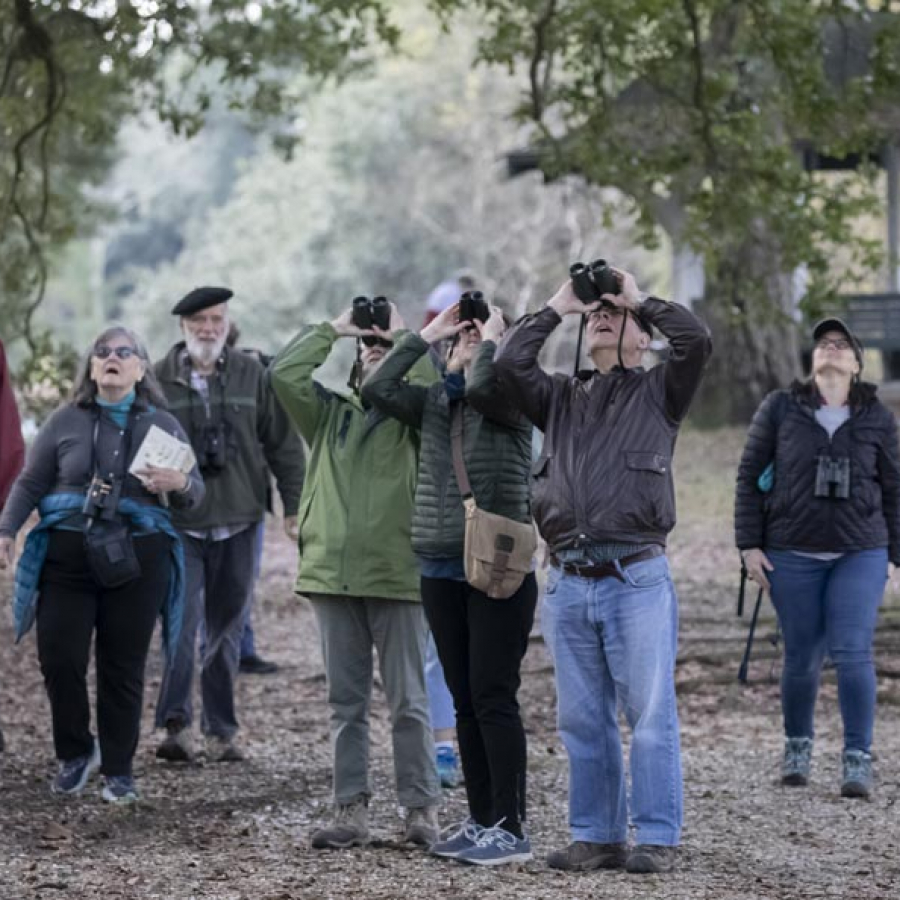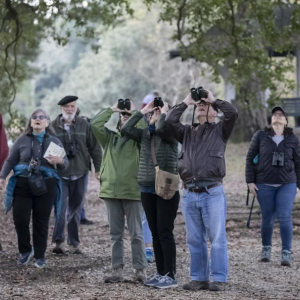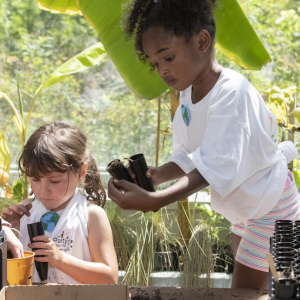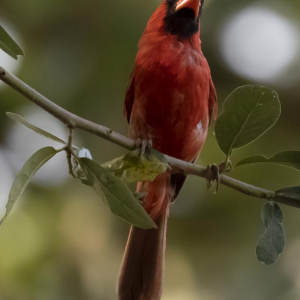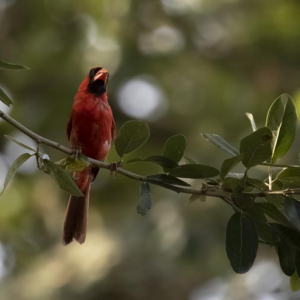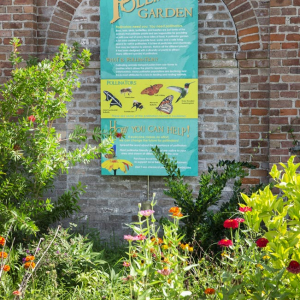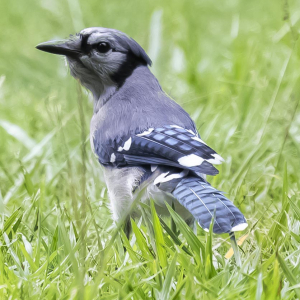As the weather begins to warm and the trees and plants bounce back from the winter freezes, it’s the perfect time to spot a vibrant red cardinal or bright blue jay, hear the coo of a mourning dove, or the melodious song of a warbler in your backyard. But birds aren’t just background players in a beautiful spring day. They are part of the group of insects, mammals and birds on which the future of life on Earth depends. That’s because birds are pollinators and seed dispersers, transferring pollen from one plant to another to help it produce fruits and seeds, then spreading those seeds throughout their habitats to allow new plants to grow.
These species pollinate over 90% of the planet’s flowering plants and one third of the human diet. While many people think of bees as the only pollinators, birds (as well as bats and other small animals, and insects like beetles and butterflies) are also in this critical category.
Despite such diversity in species, pollinators share one alarming trait: their populations are declining due to habitat loss from urban development, pollution, chemical misuse, and climate change. With these threats, pollinators like birds are losing the food and nesting sites critical for their survival.
Though you may see lots of birds in your everyday life, a 2019 study by researchers from the Cornell Lab of Ornithology, American Bird Conservancy, Smithsonian Conservation Biology Institute, U.S. Geological Survey, the Canadian Wildlife Service, and other institutions, estimated that there are nearly 3 billion fewer birds in North America today compared to 1970. That means that more than a quarter of the bird population has disappeared in just 50 years!
The reason behind this precipitous decline in bird populations involves the complex interaction of multiple environmental factors, including pesticide use, insect declines and climate change, as well as direct threats like outdoor cats and glass skyscrapers. But there is one thing all of these factors have in common—they’re driven by human actions.
Why should we care about the decline in bird populations? In addition to their important role as pollinators and speed dispersers, birds and their habitats are also important to human health and our economy. Birds aren’t just essential to pollinating crops, they also protect them by eating the insects that destroy them—especially coffee beans and wine grapes. Even if you aren’t a coffee or wine lover, everyone drinks water, and protecting bird habitats is one of the most cost-effective ways to ensure that we have access to clean drinking water, over 60% of which comes from the rivers and streams in bird habitats.
The more we study the relationship between humans and nature, the more we find what a positive impact it can have on our physical and mental wellbeing. In fact, listening to bird calls has been found to improve our moods and attention. One of the ways to enjoy those benefits from nature and birds is by birdwatching, which more than 45 million people do as a hobby. This hobby has a surprisingly large economic impact, generating nearly $96 billion in total industry output, 782,000 jobs, and $16 billion in local, state, and federal tax revenue in a single year. But you don’t have take up birdwatching or trek into the wilderness to enjoy their benefits; the presence of birds and greenspaces have been found to increase property values.
Though the decline in bird populations is a huge cause for concern, the good news is that there is plenty we can do to protect birds and their many positive impacts on our lives. While human actions may be the driving force behind the problem, they can also be the solution. Conservationists have successfully brought critically endangered bird species like the bald eagle, the whooping crane and the California condor back from the brink of extinction. Some of these actions—including wildlife management, endangered species breeding, population management, regulation of environmental hazards, and legislation protecting wildlife and their habitats—need to be carried out by conservation organizations or governmental agencies. However, there are many ways in which individuals can help both through advocating for wildlife and supporting those efforts, but also through direct action like habitat restoration and purchasing bird-friendly products.
A group of bird conservation organizations have launched the #BringBackBirds campaign, which includes seven simple actions you can take to help birds. You can learn more about these ways to help at www.3billionbirds.org.
1) Make windows bird-safe: Birds becoming injured or dying from flying into glass windows is a larger problem than you would think. Help birds recognize the glass in your windows by breaking up with the reflective surface of your windows on the outside with decals, paint, screens, or even by cleaning them less often.
2) Try to keep cats indoors: Predation by cats is the top cause of bird population decline aside from habitat loss. While cats, as predators, are just engaging in natural behaviors, we can help protect birds by keeping pet cats indoors and support the humane control of feral cat populations through measures like the Louisiana SPCA’s Trap-Neuter-Return program. TNR programs help our feline friends too by limiting breeding and the spread of disease. You can learn more on the Louisiana ASPCA website at www.louisianaspca.org/clinic/tnr.
3) Reduce lawn and plant native species: The prevalence of grass lawns in residential areas severely limits the amount of habitat available to native birds and resting places for migratory birds. Help birds and reduce the amount of time you have to spend mowing grass by planting native trees, bushes, and flowering plants in your yard instead of grass. You can go a step further and attract birds to your yard by putting out birdhouses, feeders and baths.
4) Avoid pesticides: Chemical pesticides harm or kill birds through contact or through ingestion from the food they eat and water they drink. They also reduce insects as a food source for birds and can be toxic to humans. Don’t use pesticides in your lawn and garden, and purchase organic produce grown without pesticides to help birds.
5) Drink bird-friendly coffee: Sun-grown coffee destroys bird habitats, but there are plenty of delicious shade-grown alternatives that are bird-friendly. Look for coffee labeled as certified Bird Friendly® by the Smithsonian Migratory Bird Center and encourage your local grocery store and coffee shops to stock it.
6) Reduce and reuse plastics: The list of species and habitats you can help by reducing your use of plastics is endless. Plastic pollution is a huge problem for wildlife and humans, and the best way to combat is to avoid using plastic products as much as possible (especially single-use plastics) and to find ways to reuse them rather than disposing of them. While recycling is good, it can’t keep up with the rate at which we are producing new plastic, and much of the plastic sent for recycling ends up in landfills due to batch contamination from food or non-recyclable materials.
7) Become a birdwatcher and share your observations: Knowledge is power, and you don’t need a biology degree to become a citizen scientist. Join a project such as eBird, Project FeederWatch, a Christmas Bird Count or a Breeding Bird Survey to submit your bird observations and provide scientists with valuable information about where birds are thriving and where they need our help.
We can all do our part to #BringBackBirds. You can learn more about the ways you can make a positive impact on nature and wildlife with Audubon Nature Institute at www.Action.AudubonNatureInstitute.org .
These species pollinate over 90% of the planet’s flowering plants and one third of the human diet. While many people think of bees as the only pollinators, birds (as well as bats and other small animals, and insects like beetles and butterflies) are also in this critical category.
Despite such diversity in species, pollinators share one alarming trait: their populations are declining due to habitat loss from urban development, pollution, chemical misuse, and climate change. With these threats, pollinators like birds are losing the food and nesting sites critical for their survival.
Though you may see lots of birds in your everyday life, a 2019 study by researchers from the Cornell Lab of Ornithology, American Bird Conservancy, Smithsonian Conservation Biology Institute, U.S. Geological Survey, the Canadian Wildlife Service, and other institutions, estimated that there are nearly 3 billion fewer birds in North America today compared to 1970. That means that more than a quarter of the bird population has disappeared in just 50 years!
The reason behind this precipitous decline in bird populations involves the complex interaction of multiple environmental factors, including pesticide use, insect declines and climate change, as well as direct threats like outdoor cats and glass skyscrapers. But there is one thing all of these factors have in common—they’re driven by human actions.
Why should we care about the decline in bird populations? In addition to their important role as pollinators and speed dispersers, birds and their habitats are also important to human health and our economy. Birds aren’t just essential to pollinating crops, they also protect them by eating the insects that destroy them—especially coffee beans and wine grapes. Even if you aren’t a coffee or wine lover, everyone drinks water, and protecting bird habitats is one of the most cost-effective ways to ensure that we have access to clean drinking water, over 60% of which comes from the rivers and streams in bird habitats.
The more we study the relationship between humans and nature, the more we find what a positive impact it can have on our physical and mental wellbeing. In fact, listening to bird calls has been found to improve our moods and attention. One of the ways to enjoy those benefits from nature and birds is by birdwatching, which more than 45 million people do as a hobby. This hobby has a surprisingly large economic impact, generating nearly $96 billion in total industry output, 782,000 jobs, and $16 billion in local, state, and federal tax revenue in a single year. But you don’t have take up birdwatching or trek into the wilderness to enjoy their benefits; the presence of birds and greenspaces have been found to increase property values.
Though the decline in bird populations is a huge cause for concern, the good news is that there is plenty we can do to protect birds and their many positive impacts on our lives. While human actions may be the driving force behind the problem, they can also be the solution. Conservationists have successfully brought critically endangered bird species like the bald eagle, the whooping crane and the California condor back from the brink of extinction. Some of these actions—including wildlife management, endangered species breeding, population management, regulation of environmental hazards, and legislation protecting wildlife and their habitats—need to be carried out by conservation organizations or governmental agencies. However, there are many ways in which individuals can help both through advocating for wildlife and supporting those efforts, but also through direct action like habitat restoration and purchasing bird-friendly products.
A group of bird conservation organizations have launched the #BringBackBirds campaign, which includes seven simple actions you can take to help birds. You can learn more about these ways to help at www.3billionbirds.org.
1) Make windows bird-safe: Birds becoming injured or dying from flying into glass windows is a larger problem than you would think. Help birds recognize the glass in your windows by breaking up with the reflective surface of your windows on the outside with decals, paint, screens, or even by cleaning them less often.
2) Try to keep cats indoors: Predation by cats is the top cause of bird population decline aside from habitat loss. While cats, as predators, are just engaging in natural behaviors, we can help protect birds by keeping pet cats indoors and support the humane control of feral cat populations through measures like the Louisiana SPCA’s Trap-Neuter-Return program. TNR programs help our feline friends too by limiting breeding and the spread of disease. You can learn more on the Louisiana ASPCA website at www.louisianaspca.org/clinic/tnr.
3) Reduce lawn and plant native species: The prevalence of grass lawns in residential areas severely limits the amount of habitat available to native birds and resting places for migratory birds. Help birds and reduce the amount of time you have to spend mowing grass by planting native trees, bushes, and flowering plants in your yard instead of grass. You can go a step further and attract birds to your yard by putting out birdhouses, feeders and baths.
4) Avoid pesticides: Chemical pesticides harm or kill birds through contact or through ingestion from the food they eat and water they drink. They also reduce insects as a food source for birds and can be toxic to humans. Don’t use pesticides in your lawn and garden, and purchase organic produce grown without pesticides to help birds.
5) Drink bird-friendly coffee: Sun-grown coffee destroys bird habitats, but there are plenty of delicious shade-grown alternatives that are bird-friendly. Look for coffee labeled as certified Bird Friendly® by the Smithsonian Migratory Bird Center and encourage your local grocery store and coffee shops to stock it.
6) Reduce and reuse plastics: The list of species and habitats you can help by reducing your use of plastics is endless. Plastic pollution is a huge problem for wildlife and humans, and the best way to combat is to avoid using plastic products as much as possible (especially single-use plastics) and to find ways to reuse them rather than disposing of them. While recycling is good, it can’t keep up with the rate at which we are producing new plastic, and much of the plastic sent for recycling ends up in landfills due to batch contamination from food or non-recyclable materials.
7) Become a birdwatcher and share your observations: Knowledge is power, and you don’t need a biology degree to become a citizen scientist. Join a project such as eBird, Project FeederWatch, a Christmas Bird Count or a Breeding Bird Survey to submit your bird observations and provide scientists with valuable information about where birds are thriving and where they need our help.
We can all do our part to #BringBackBirds. You can learn more about the ways you can make a positive impact on nature and wildlife with Audubon Nature Institute at www.Action.AudubonNatureInstitute.org .
Tagged in Zoo Dat in our Spring 2022 issue
